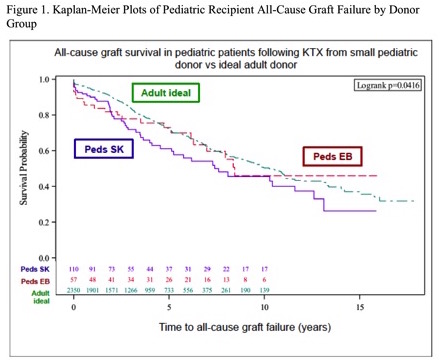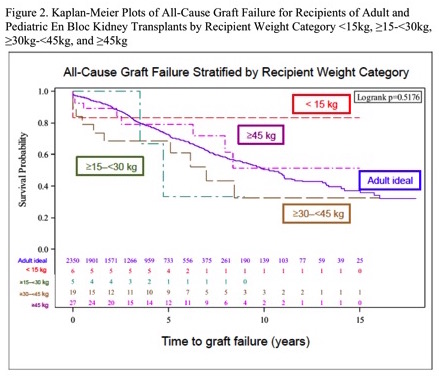Small Pediatric Donor Kidney Transplantation in Pediatric Recipients.
1Surgery, Montefiore Medical Center, Bronx, NY
2Surgery, Albert Einstein College of Medicine, Bronx, NY
3Surgery, Erie County Medical Center, Buffalo, NY
Meeting: 2017 American Transplant Congress
Abstract number: D183
Keywords: Graft survival, Kidney transplantation, Outcome, Pediatric
Session Information
Session Name: Poster Session D: Kidney: Pediatric
Session Type: Poster Session
Date: Tuesday, May 2, 2017
Session Time: 6:00pm-7:00pm
 Presentation Time: 6:00pm-7:00pm
Presentation Time: 6:00pm-7:00pm
Location: Hall D1
Kidneys from small pediatric donors (age <5 years, weight <21 kg) may be a means to increase the donor pool for pediatric recipients. Transplantation of small pediatric kidneys is more commonly performed in adult recipients due to the increased risks of technical complications, thrombosis, and early graft failure. While these risks are abrogated in adult recipients by limiting the donor weight to ≥10 kg and using en bloc (EB) technique, it is unknown whether pediatric recipients achieve comparable results. SRTR data were assessed for all first-time, deceased-donor, kidney-only pediatric recipients, 1/1996-10/2013, who received small pediatric donor grafts or grafts from ideal adult donors (aged 18-39 years without a history of hypertension, diabetes, terminal serum creatinine >1.5, or death due to CVA). We identified 57 pediatric EB, 110 pediatric single kidney (SK), and 2350 adult transplants. The primary outcome was 3-year all-cause graft survival. Kaplan-Meier curves showed worse early outcomes for pediatric grafts compared to adult ideal grafts (p=0.042).  When stratified by recipient weight category, there was a suggestion of worse all-cause graft failure rates when transplanted with an EB graft compared to adult ideal donors (p=0.52).
When stratified by recipient weight category, there was a suggestion of worse all-cause graft failure rates when transplanted with an EB graft compared to adult ideal donors (p=0.52).  On multivariate analysis, pediatric recipients of SK grafts had significantly higher hazard ratios (aHR 2.01, 95% CI 1.34-3.00) and pediatric recipients of en bloc pediatric kidneys had somewhat higher non-significant hazard ratios (1.57; 95% CI 0.88-2.79) for graft failure. These results suggest cautionary use of small pediatric donors as a source to expand the donor pool for pediatric candidates.
On multivariate analysis, pediatric recipients of SK grafts had significantly higher hazard ratios (aHR 2.01, 95% CI 1.34-3.00) and pediatric recipients of en bloc pediatric kidneys had somewhat higher non-significant hazard ratios (1.57; 95% CI 0.88-2.79) for graft failure. These results suggest cautionary use of small pediatric donors as a source to expand the donor pool for pediatric candidates.
CITATION INFORMATION: Yaffe H, Friedmann P, Kayler L. Small Pediatric Donor Kidney Transplantation in Pediatric Recipients. Am J Transplant. 2017;17 (suppl 3).
To cite this abstract in AMA style:
Yaffe H, Friedmann P, Kayler L. Small Pediatric Donor Kidney Transplantation in Pediatric Recipients. [abstract]. Am J Transplant. 2017; 17 (suppl 3). https://atcmeetingabstracts.com/abstract/small-pediatric-donor-kidney-transplantation-in-pediatric-recipients/. Accessed December 14, 2025.« Back to 2017 American Transplant Congress
